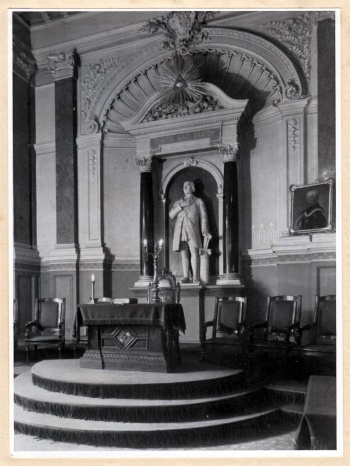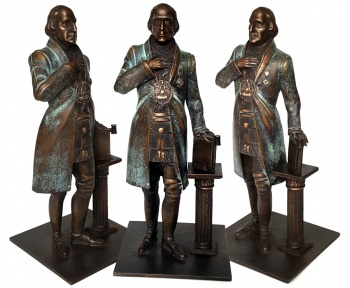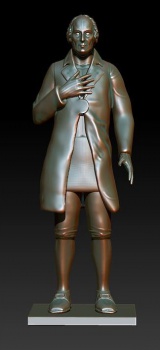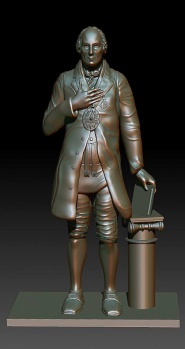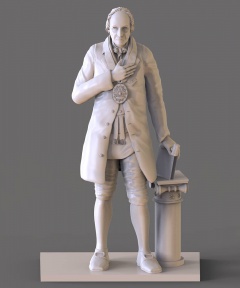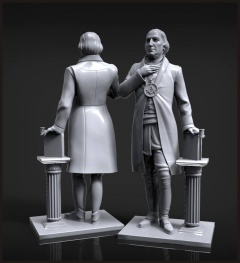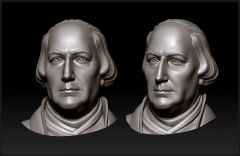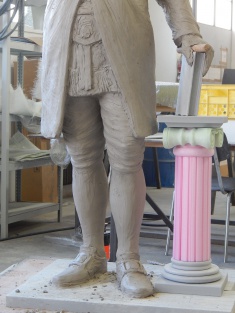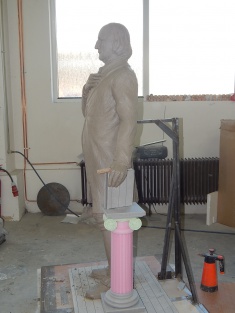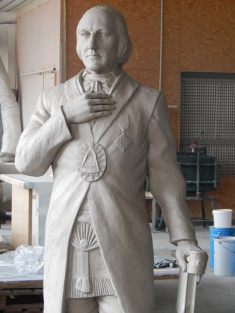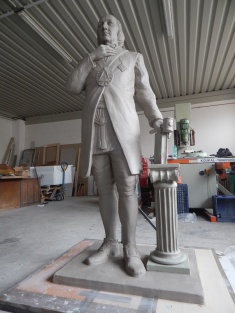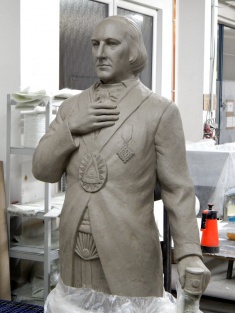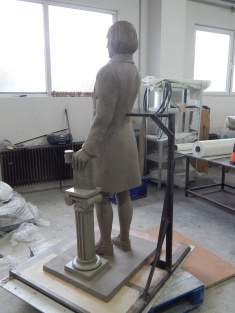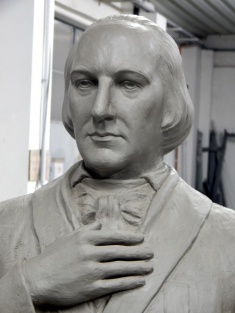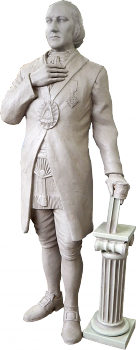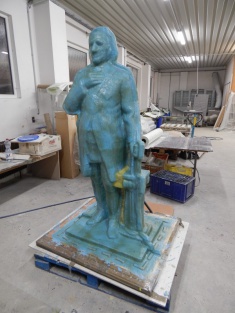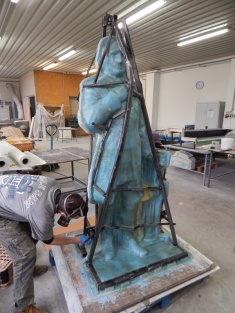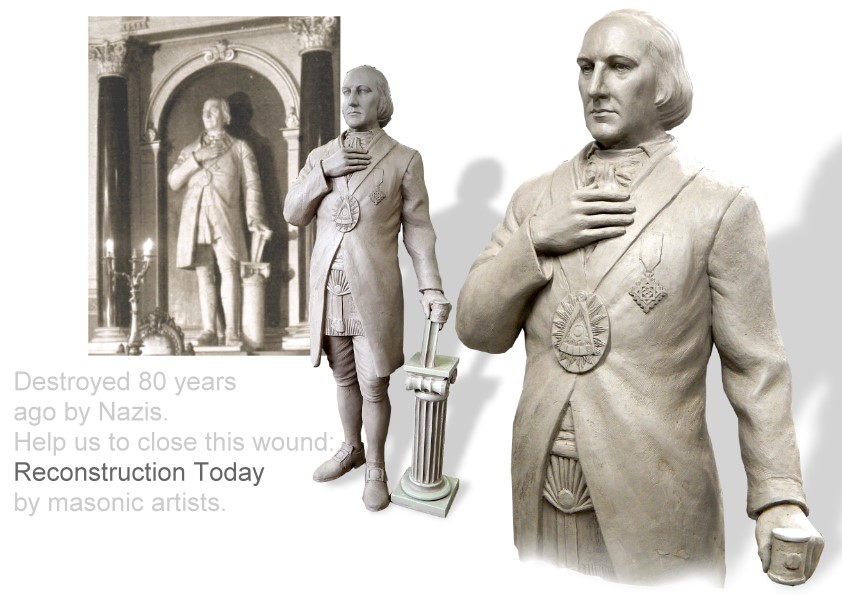En: Project reconstruction of the statue of Friedrich-Ludwig Schröder, status summer 2017
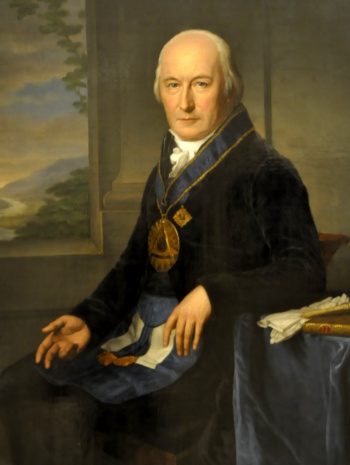
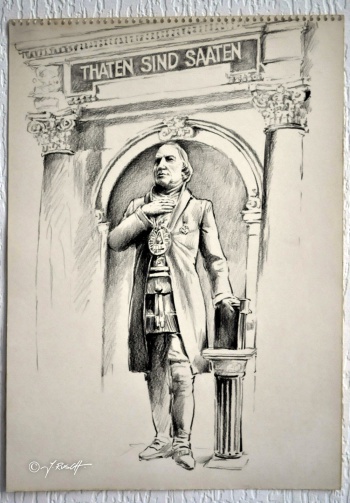
The reconstruction of the statue of Friedrich Ludwig Schröder
October 24, 2017 by David Harrison
Friedrich Ludwig Schröder (1744–1816) was one of the most significant reformers in German masonic history, creating his own rite and also being an influence on the culture of Germany, counting amongst his friends Lessing and Goethe.
During the lead up to World War II, the Nazis occupied the Grand lodge in” Welckerstrasse” in the city of Hamburg back in 1937. First, they used the lodge for an anti-masonic exhibition, and after that they ordered it teared down. The easiest way for them was to burn it, like the Nazis used to do with institutions that where proclaimed anti-German, but not in this case. Their intentions were to reveal the secrets of the Freemasons, and they dismantled the building piece by piece – finding nothing. In a rage, the Nazis destroyed the statue of the founder of the Grand lodge Friedrich Ludwig Schröder. With this act, they destroyed not only important masonic history, but also valuable German culture.
In was in 2016 when WM Hans-Peter Meissner (Lodge “Absalom zu den drei Nesseln) and the German artist and brother Jens Rusch (Lodge “Roland”) had a talk about what happened almost 80 years ago. They agreed that something had to be done, not only for the reconstruction itself, but mostly to send a signal to the public worldwide, that what was destroyed during this dark time in history could be reconstructed.
But how could this be done? It seems there were no eyewitnesses back from that time. The only proof of this statue was an old photograph of the statue on its previous place and an old oil painting of the Grandmaster Friedrich Ludwig Schröder. This oil painting is still in the reestablished lodge in Hamburg. Later there was found an eyewitness in brother Rolf Appel (born 1921), who saw the Nazis destroying the statue, when he visited the site together with his father, also a dedicated freemason. Brother Rolf only saw the act of destroying, but could not clear questions regarding the reconstruction itself. He follows the project with high interest, and hope that the statue will be placed in the lodge again after reconstruction. His memories about this act are well documented and saved for the future.
Via the homepage www.encyclopedia-masonica.com and Facebook, a group of interested freemasons was formed. The task for the group was to facilitate the reconstruction of this statue” pro bono” and” non-profit”. The goal was, and still is, to guarantee that this statue will be exhibited for the public, not only as an act of honouring Schröder, but also to send a signal to the world, a signal that is very important in the year 2017. There will be two versions reproduced in full-size: one in marble for display inside the lodge and one cast in bronze for display outside the lodge accessible for the public.
Here are some pictures that show the progress of the reconstruction of this important statue of Friedrich Ludwig Schröder: Website Br David Harrison
Project reconstruction of the statue of Friedrich-Ludwig Schröder, status summer 2017
Friedrich Ludwig Schröder (1744 – 1816) has, beside being one of the most significant reformers in German masonic history, also created his own rite. He was an important influencer in past cultural life, having his friends Lessing, Goethe and more at his side. He was also, among many other for freemasonry and cultural life important issues, the founder of the ”Hamburgische Nationaloper”, which today is one of the most significant Operas in Germany.
The German Nazis occupied the Grand lodge in ”Welckerstrasse” in the city of Hamburg back in 1937. First, they used the lodge for an anti-masonic exhibition, and after that they ordered it teared down. The easiest way for them was to burn it, like the Nazis used to do with institution that where proclaimed anti-German, but not in this case. Their intentions were to reveal the secrets of the Freemasons, and they dismantled the building stone by stone – finding nothing. In a rage, the Nazis destroyed the statue of the founder of the Grand lodge Friedrich-Wilhelm Schröder. With this act, they destroyed not only important masonic history, but also valuable German culture.
Until the year 2016, nobody could or would take up the burden it was to reconstruct this statue. Until the day when WM Hans-Peter Meissner (Lodge “Absalom zu den drei Nesseln) and the German artist and brother Jens Rusch (Lodge “Roland”) had a talk about what happened almost 80 years ago. They agreed that something had to be done, not only for the reconstruction itself, but mostly to send a signal to the public worldwide, that nevertheless what has been destroyed during this dark time can be reestablished.
But how could this have been done? There were no eyewitnesses back from that time! The only proof of this statue was an old photography of the statue on its previous place, and an old oil painting of the Grandmaster Friedrich Ludwig Schröder.
This oil painting is still in the reestablished lodge in Hamburg. Via the homepage www.encyclopedia-masonica.com and Facebook, a group of interested freemasons was shaped. The task for the group was to facilitate the reconstruction of this statue ”pro bono” and” non-profit”. The goal was and still is to guarantee that this statue will be exhibited for the public, as an act of honoring F.L. Schröder, but also to send a signal to the world, a signal that we see as being very important in the year 2017.
Some few pictures following will show the progress of the reconstruction of this important statue of Friedrich Ludwig Schröder.
Accompanying commentary by Bro David S. Owens
First, I will set forth some information about the artist and Mason, Jens Rusch, so that the following can be properly understood.Brother Jens Rusch occupies a somewhat unusual position in German Freemasonry. Although he does not hold a significant office, his role can be described as "not insignificant".
This is due to the fact that he does not feel obliged to any of the Masonic teaching methods practiced in Germany alone. Only then was it possible to have such a huge, common platform as the online lexicon www.encyclopedia-masonica.com.
He did this for years on his own, had to endure hacker attacks and the threat of honorary tribunals and survive. But times change. Today, well over 40 million page views and more than 5,000 meticulously compiled content pages are of high value for this Masonic public relations tool.The Grand Master of the United Grand Lodge of Germany, Brother Christoph Bosbach recently awarded Brother Jens Rusch the golden merit badge "Pro Merito" for this huge achievement and the enormous perseverance of the cancer-stricken brother. He was described as a "traitor", to nowa highly valued knowledge facilitator. His team of brothers and also sisters, of the leaders and top-class staff of archives and museums has grown significantly.
Many of today's Freemasons thus received their first, serious knowledge of Freemasonry, which in Germany is also called "Royal Art". Often, his editorial staff receives letters of thanks in this spirit. Meanwhile, there is a support association for the preservation of the online lexicon, which in Germany is called "Freemason Wiki". The chairman is none other than Grand Master Brother Bernd Brauer. The magazine-like lexicon has thus become sustainable.
Rusch designed and produced many jewels and designed working carpets for German lodges, book titles and illustrations. They all have one thing in common: He basically worked "pro bono"and out of the goodness of his heart, so he did not take any fees.
When he was asked by the lodge master of the oldest German lodge "Absalom to the Three Nettles" in the Orient Hamburg, if it was technically feasible to reconstruct a life-size figure froman indistinct photo of a statue destroyed by the Nazis, he took the daunting request without hesitation and at no time did he demand even a penny for this increasingly time-consuming task. It was the pure Masonic idealism that drove him for over two years. No one thought about a contract or an official task structure at this time. Why? No one thought it was ever necessary.
Quote from Grand Master Stephan Roth-Kleyer:“I wish the brothers responsible for this project much success. I would be very happy to be able to see the life-size statue of our brother and great Masonic reformer, Friedrich Ludwig Schröder, during one of my next visits to Hamburg. I would like to encourage you, my brothers, to help with this project.”
In addition to this, the artist Jens Rusch was increasingly forced to indulge in what the Nazis had done to German Freemasonry, but also the horror at how inadequately discussed the atrocities done to German Freemasonry in the post-war period.
Instead, such atrocities were opressed and hushed. Jens contacted authors and contemporaries who also dealt with the topic of "oppression". He received very similar information from Spain, where only today the atrocities of the Franco regime are discussed and not oppressed. Such information is also kept in a large archive in Salamanca. From Israel, Denmark, to Iceland, the growing project of reconstruction received great recognition.Thus, the enormously complex artistic task became a symbolic act instead.
When I recognized the increased level of difficulty of this artistic task, I decided to support Brother Jens Rusch in the accomplishment of this task. The world needs to know the damage the Nazis did to their own country as well. Everyone knows how they persecuted people, but not what they did to the Freemasons.
Quote by Brother Jens Rusch:“I am delighted that far-sighted Brothers like David S. Owens have also recognized these relationships. Unfortunately, there is currently little evidence of sustained support for this reconstruction project in Germany; on the contrary, negative voices can be heard.”In response to the oppression, Jens stated that:“This reflection is becoming more and more important on a daily basis, because the sprouting of a new and violent right-wing populism in Germany has not left its mark on the lodges in the former GDR. One can only prevent the story from repeating itself in a fatal way, if you face yourown past.
”Quote from Arno Schmidt, German author and translator: "Germany may take the role of the stone in history, over which humanity has stumbled many times.”
David S. Owens
Contact
Gallery
Phase 3
This handmade clay figure was made by the company Expo: nat in Vrabce / Czech Republic in autumn 2017. Workshop manager and artist Lukas Bravenec did an excellent job.
Phase 4
Phase 5
See also
- Friedrich Ludwig Schröder
- Schrödersche Lehrart
- Strikte Observanz
- Ansprache des Großmeisters Br Richard Bröse 1935
Links
- Dr. David Harrison about "The reconstruction of the statue of Friedrich Luwig Schröder https://dr-david-harrison.com/freemasonry/reconstruction-statue-friedrich-ludwig-schroder/

